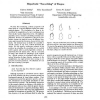9 search results - page 1 / 2 » Hyperbolic "Smoothing" of Shapes |
ICCV
1998
IEEE
13 years 9 months ago
1998
IEEE
We have been developing a theory of generic 2-D shape based on a reaction-diffusion model from mathematical physics. The description of a shape is derived from the singularities o...
CVPR
2009
IEEE
14 years 12 months ago
2009
IEEE
All surfaces can be classified by the conformal equivalence
relation. Conformal invariants, which are shape indices
that can be defined intrinsically on a surface, may
be used t...
CAGD
2004
13 years 4 months ago
2004
For subdivision surfaces, it is important to characterize local shape near flat spots and points where the surface is not twice continuously differentiable. Applying general princ...
CAD
2004
Springer
13 years 4 months ago
2004
Springer
Despite its usefulness in many applications, the medial axis transform (MAT) is very sensitive to the change of the boundary in the sense that, even if a shape is perturbed only s...
CVPR
1997
IEEE
13 years 9 months ago
1997
IEEE
— A number of active contour models have been proposed that unify the curve evolution framework with classical energy minimization techniques for segmentation, such as snakes. Th...

